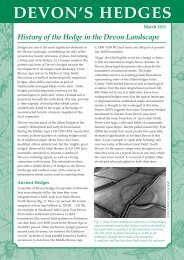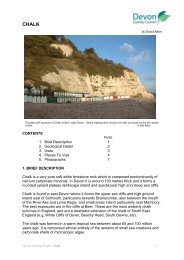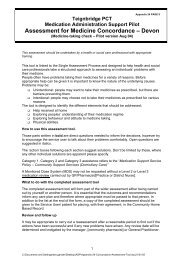00642 Verges Booklet - Devon County Council
00642 Verges Booklet - Devon County Council
00642 Verges Booklet - Devon County Council
You also want an ePaper? Increase the reach of your titles
YUMPU automatically turns print PDFs into web optimized ePapers that Google loves.
(viii) Giant Hogweed (Heracleum mantegazzianum)<br />
Description<br />
Starts growing in March-April, reaching 3 to 5 metres in<br />
height. The leaves are dark green, in a rosette, lobes<br />
deeply cut and spikey at the ends.The stem is dark redpurple<br />
spots or blotches up to 100mm across. The<br />
flowers are white forming one large umbrella-like<br />
flower head that appears in June-July.<br />
Legislation<br />
The Wildlife and Countryside Act 1981 makes it an offence to plant or<br />
cause Giant Hogweed to grow in the wild.<br />
Further Information and Control<br />
Giant Hogweed, a native of the Caucasus mountains between Russia<br />
and Turkey, was introduced to Britain as an ornamental plant in the late<br />
19th Century. It is now widespread throughout the British Isles<br />
especially along river banks.<br />
The control of these plants by non-chemical methods should always be<br />
considered as the first option. However, this form of management is<br />
often labour intensive and time-consuming. Plants may be dugout, but<br />
care should be taken to remove much of the root stalk. Cattle, sheep,<br />
goats and pigs are also cited as possible methods of control as they eat<br />
Giant Hogweed without apparent harm, trampling also damages the<br />
plant.<br />
Chemical control should only be considered only after non-chemical<br />
control has been evaluated and has proved impracticable.The herbicide<br />
glyphosate is currently the most effective chemical control for Giant<br />
Hogweed.<br />
WARNING<br />
The hollow stems are attractive to children who use them as “pea shooters”<br />
and “telescopes”. However the stems and edges and undersides of the leaves<br />
bear small hairs which are coated with poisonous sap and causes blistering<br />
and severe irritation. It should not be touched without wearing protective<br />
clothing. Giant Hogweed is a potential danger to public health. Seek medical<br />
advice if blistering occurs.

















